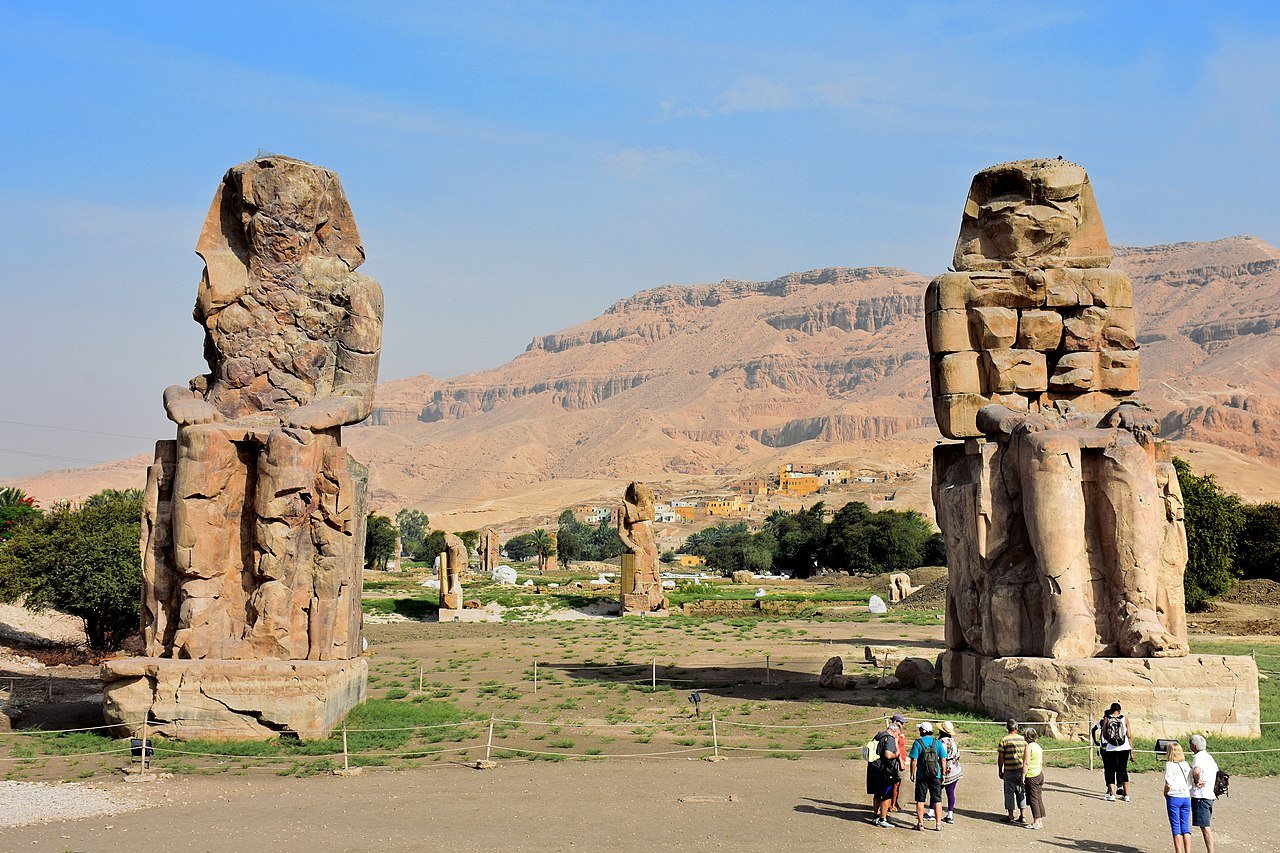Colossi of Memnon: 3 Legendary Reasons to Meet the Silent Guardians of Luxor
Colossi of Memnon: The Silent Guardians of Luxor
On the west bank of the Nile in Luxor, two giants sit in silence, gazing eastward toward the rising sun. These are the Colossi of Memnon—two massive statues of Pharaoh Amenhotep III that have stood for more than 3,400 years. Carved from enormous blocks of quartzite sandstone transported all the way from Cairo, the statues are among the most iconic landmarks in Egypt.
Even though they are all that remain of a once-magnificent mortuary temple, the Colossi carry with them layers of myth, mystery, and enduring grandeur. For travelers, they’re not just monuments—they’re storytellers of ancient power, natural forces, and timeless wonder.
1. What Made the Statues “Sing”?
One of the most fascinating legends surrounding the Colossi of Memnon is the mystery of the “singing statue.” After an earthquake in 27 BCE cracked the northern statue, visitors began reporting a haunting sound at dawn—described as a hum, whistle, or even the voice of a god.
To the Greeks, this was the call of Memnon, the heroic king of Ethiopia, son of Eos (goddess of the dawn). They believed he was crying out to his mother each morning as the sun rose. This phenomenon became so famous that Roman emperors and poets traveled to Thebes to hear the statue “sing.” Even Emperor Hadrian himself recorded hearing the sound during his visit.
Later restorations during the Roman period reinforced the stone and silenced the sound forever, but the legend has lived on. Today, the story of the “singing statue” continues to enchant visitors, blending myth and history in a way that makes the Colossi unforgettable.
2. Why Do the Colossi Matter in Egyptian History?
The Colossi of Memnon weren’t just colossal statues placed at random—they were part of the entrance to the grand Mortuary Temple of Amenhotep III. This temple, now mostly lost, was one of the largest ever built in Egypt, covering an area even bigger than Karnak Temple. Floods, earthquakes, and centuries of stone quarrying dismantled most of it, but the two statues endured.
Each statue stands around 18 meters (nearly 60 feet) tall and weighs about 720 tons. They depict Amenhotep III seated on a throne, hands resting on his knees, facing east to greet the sunrise. Their position wasn’t symbolic alone—it was meant to project divine power, guarding the Pharaoh’s eternal resting place and the Theban necropolis behind them.
Visitors looking closely will notice smaller carvings along the legs of the statues. These are figures of Amenhotep’s queen, Tiye, and his mother, Mutemwiya, showing the Pharaoh’s close ties to his royal lineage. Such details make the Colossi more than just stone guardians—they are historical records carved in sandstone.
3. How Can You Make the Most of Your Visit?
The Colossi of Memnon are an open-air site with no entry fee, making them one of the easiest and most rewarding stops in Luxor. To make your visit truly special, consider these tips:
- Arrive at sunrise: The early morning light bathes the statues in golden tones, perfect for photos and reflection.
- Bring a wide-angle lens: Their massive scale can be hard to capture without one.
- Listen to local stories: Guides often share versions of the Memnon legend that add richness to the experience.
- Pair your visit: The Colossi are located on the way to other major sites on Luxor’s West Bank, like the Valley of the Kings, the Temple of Hatshepsut, and the Ramesseum.
Since the site is outdoors and quick to explore, it’s often combined with larger tours of Luxor’s west bank. Yet, even a short stop can leave a deep impression when you consider the weight of their history and the legends attached to them.
The Colossi in Literature and Culture
The fascination with the Colossi didn’t stop in antiquity. Ancient Greek and Roman writers penned poems about the “singing statue,” and the site is referenced in works of classical literature. Later, travelers in the 18th and 19th centuries, during the age of exploration, wrote glowing accounts of standing before these silent giants. They became symbols of the mysterious, timeless aura of Egypt—a land where myth and reality overlap.
Why the Colossi Are More Than Just Statues
Standing before the Colossi, you realize they are not simply ancient relics—they are survivors. They’ve withstood earthquakes, Nile floods, looting, and centuries of neglect. Yet, they still rise above the Theban plain, unchanged in their watch over the land.
For Egyptologists, they are crucial markers of Amenhotep III’s reign, reflecting a time when Egypt was at its peak in wealth, art, and influence. For travelers, they’re a reminder of how ancient civilizations communicated their power—through sheer scale and enduring craftsmanship.
Explore with Egypt Safari Tours
At Egypt Safari Tours, we take you beyond just looking at the Colossi—we immerse you in their history and legends. Imagine starting your day with a sunrise visit, when the light brings the statues to life, before continuing to explore the wonders of Luxor’s West Bank.
Our expert guides share the myths of Memnon, the story of Amenhotep III, and the secrets of Thebes in ways that make history come alive. Whether you want to pair your Colossi visit with a felucca ride on the Nile, explore hidden tombs in the Valley of the Queens, or walk through the grand halls of Karnak Temple, we craft experiences that connect you deeply with Egypt’s timeless past.
✨ Start your journey with us today—and let the Silent Guardians of Luxor welcome you to their eternal watch.




